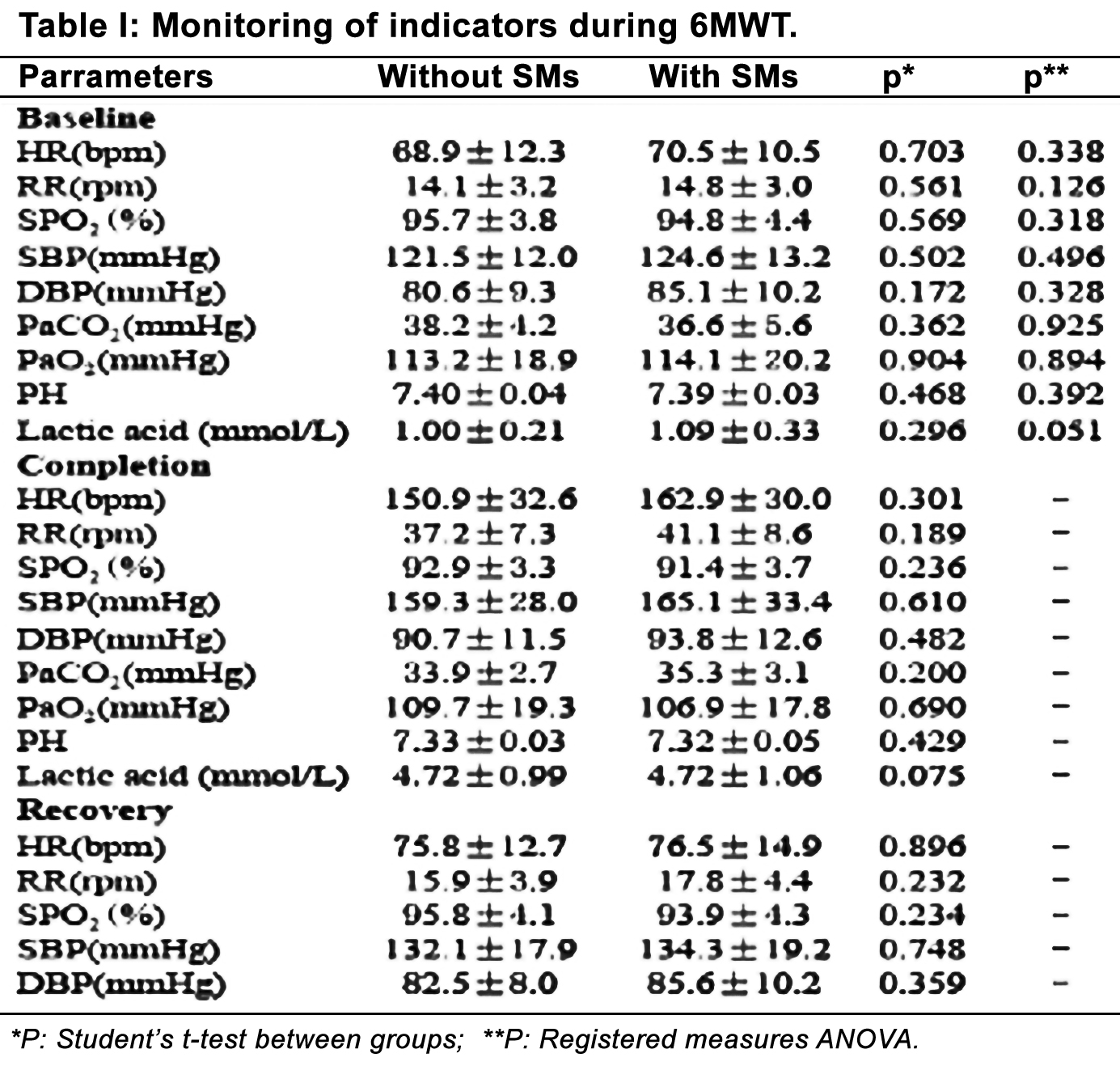Effects of Surgical Masks on Patients with Stable Chronic Heart Failure
By Danxin Meng1, Yimin Li2, Jin Huang1Affiliations
doi: 10.29271/jcpsp.2023.06.711
Sir,
This study aimed to assess whether patients with stable chronic heart failure (CHF) can wear a surgical mask (SM) for rehabilitation exercises through a 6-minute walk test (6MWT). Fifteen patients with stable CHF with a NYHA II cardiac functional classification were included. Participants completed a 6MWT with and without a SM. Baseline and post-exercise vital signs, blood gas analysis, and other indicators (rating of perceived exertion [RPE]) were recorded and analysed. The results showed that the average distance covered without SMs was 408.7±58.0 m, slightly more than with SMs, 392.4±62.0 m; however, no significant difference was found between the groups (p = 0.463) (Figure 1A). The speed to complete 6MWT without SMs was faster, while the difference was also not statistically significant (68.1±9.6 m/min vs. 65.4±10.3 m/min, p = 0.461) (Figure 1B). Compared to those patients without SMs, the classification of 6MWT in patients with SMs decreased (Z = -2.119, p = 0.034) (Figure 1C). During the peri-exercise period, no significant differences were found in vital signs (including heart rate, respiratory rate, blood pressure and finger pulse oxygen) and blood gas indexes (including PH, PaCO2, PaO2, LA) in patients with or without SMs (All p >0.05, Table I). Compared to those without SMs, the RPE score for completing 6MWT with SMs was slightly higher, but there was no significant difference between the groups (3.1±1.6 vs. 3.3±2.0, p =0.684, Figure 1D).
Several contradictions exist in previous studies regarding the changes in physiological status during exercise with masks.1 Chandrasekaran et al. concluded that wearing masks during exercise would increase the work of breathing and decrease arterial oxygen saturation.2 In addition, wearing masks during exercise would lower the maximum forced vital capacity, and forced expiratory volume in the 1st second, and significantly reduce the mean duration of the incremental exertion test.3 Nevertheless, there were no significant differences in the metabolic parameter changes including pH, pCO2, PO2, lactic acid, and heart rate. Arterial saturation remained above 97% while wearing a SM or N95 respirator while exercising at moderate intensity for 60 minutes, indicating that the changes in PaO2 sufficient to affect ventilation are unlikely.4 In the current study, no significant differences were found in vital signs and blood gas indices during 6MWT with or without SMs. The results confirmed the safety of mild exercise in patients with CHF.
Currently, masks have been recommended as a critical intervention to tackle the COVID-19 pandemic.5 SMs should be recommended as a routine protection strategy in rehabilitation exercises in the patients with CHF.

 Figure 1: (A) Distance of 6-minute walk test (6MWT) in participants without surgical masks (SMs) or with SMs. (B) The speed of 6MWT in participants without SMs or with SMs. (C) The classification of 6MWT in participants without SMs or with SMs. (D) The rating of perceived exertion (RPE) score of 6MWT in participants without SMs or with SMs.
Figure 1: (A) Distance of 6-minute walk test (6MWT) in participants without surgical masks (SMs) or with SMs. (B) The speed of 6MWT in participants without SMs or with SMs. (C) The classification of 6MWT in participants without SMs or with SMs. (D) The rating of perceived exertion (RPE) score of 6MWT in participants without SMs or with SMs.
COMPETING INTEREST:
The authors declared no competing interest.
AUTHORS’ CONTRIBUTION:
MD: Performed the study and drafted the manuscript.
YL: Designed the study and revised the manuscript.
JH: Reviewed the manuscript.
All the authors have approved the final version of the manuscript to be published.
REFERENCES
- Pelliccia A, Sharma S, Gati S. 2020 ESC Guidelines on sports cardiology and exercise in patients with cardio-vascular disease. Russian J Cardiol 2021, 26(5): 4488.
- Chandrasekaran B. Fernandes S. Exercise with Facemask; Are We Handling a devil’s sword? A Physiological Hypothesis. Med Hypothesis 2020; 144:110002. doi: 10. 1016/j.mehy.2020.110002.
- Fikenzer S, Laufs U, Fikenzer S, Uhe T, Lavall D, Rudolph U, et al. Effects of surgical and FFP2/N95 face masks on cardiopulmonary exercise capacity. Clin Res Cardio Clin Res Cardiol 2020; 12:1600.
- Hopkins SR, Dominelli PB, Davis CK, Guenette JA, Luks AM, Molgat-Seon Y, et al. Face masks and the cardio-respiratory response to physical activity in health and disease. Ann Am Thorac Soc 2021; 18(3):399-407. doi: 10.1513/AnnalsATS.202008-990CME.
- Howard J, Huang A, Li Z, Tufekci Z, Zdimal V, Delft AV, et al. An evidence review of face masks against COVID-19. Proc Natl Acad Sci U S A 2021; 118(4):e2014564118. doi: 10.1073/pnas.2014564118.